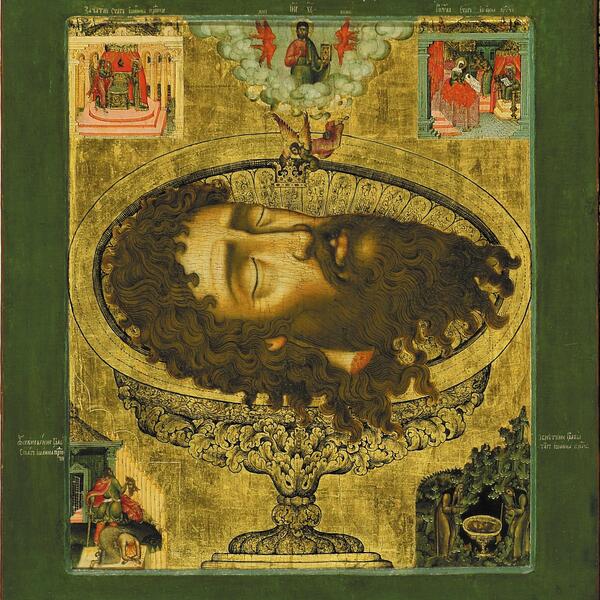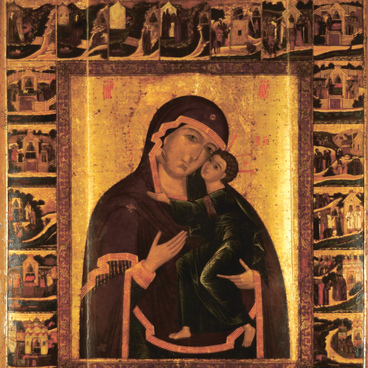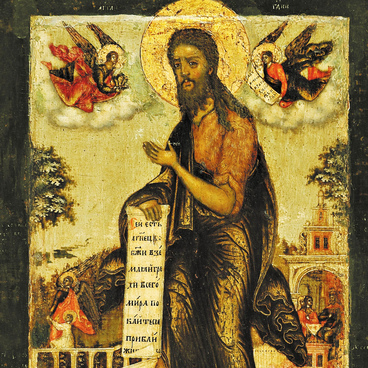John the Baptist, who was the precursor of Jesus Christ and baptized the Savior in the Jordan River, is one of the most celebrated and venerated saints. While preaching repentance, he also strove to protect the Jewish law. Having found out about the unlawful wedding between Herodias and King Herod Antipas, the half-brother of her ex-husband, John criticized the king and was arrested. Herodias was angered by his behavior and wished him dead. She sought revenge and involved her daughter Salome in achieving it. Salome danced before Herod Antipas and in return asked for the head of John the Baptist. Her wish was fulfilled.
John’s disciples took his body away and buried it in Sebastia. However, Herodias was afraid that John could come back to life and requested for his head not to be buried with his body. The righteous wife of Chuza, Herod’s steward, secretly buried John’s head in a vessel on the Mount of Olives. Having heard about the miracles of Jesus and discovered that the head was missing, Antipas and Herodias concluded that Jesus was actually John the Baptist risen from the dead.
The severed head of John the Baptist, secretly buried and thrice discovered by devout Christians, is one of the oldest Christian relics. The scene of the beheading of John has often been portrayed in hagiographical icons.
The Yaroslavl icon from the exhibition is unique in that it tells the story of both the saint’s life and the relic. The central image of the severed head is surrounded by four border scenes: “the Annuli to Zacharias” where the angel informs him that he will soon have a son, “the Nativity of John the Baptist”, “the Beheading of John the Baptist”, and “the Discovery of the Head of John the Baptist”. Although the size of each scene is only around 5 by 5 cm, the miniatures are highly detailed.
The icon was created in the 1680s for the Church of Elijah the Prophet and was placed in the side altar of Barlaam of Khutyn. Ulita Makarovna Skripina, the last representative of a dynasty of merchants and philanthropists, commissioned the painting of the church to the brotherhood of icon painters under Gury Nikitin. The icon was painted by one of the masters of Nikitin’s group.
In 1660, Gury Nikitin was certified as a first-class icon painter but for some reason, he did not get a job as a master of the Armory Chamber. He was head of the Kostroma icon painting school and fulfilled many highly important orders. His artistic style was based on creating monumental images and reflecting the spiritual strength of those portrayed. In some cases, he adhered to the canon, while in others he improvised, allowing unique interpretations and motifs.
John’s disciples took his body away and buried it in Sebastia. However, Herodias was afraid that John could come back to life and requested for his head not to be buried with his body. The righteous wife of Chuza, Herod’s steward, secretly buried John’s head in a vessel on the Mount of Olives. Having heard about the miracles of Jesus and discovered that the head was missing, Antipas and Herodias concluded that Jesus was actually John the Baptist risen from the dead.
The severed head of John the Baptist, secretly buried and thrice discovered by devout Christians, is one of the oldest Christian relics. The scene of the beheading of John has often been portrayed in hagiographical icons.
The Yaroslavl icon from the exhibition is unique in that it tells the story of both the saint’s life and the relic. The central image of the severed head is surrounded by four border scenes: “the Annuli to Zacharias” where the angel informs him that he will soon have a son, “the Nativity of John the Baptist”, “the Beheading of John the Baptist”, and “the Discovery of the Head of John the Baptist”. Although the size of each scene is only around 5 by 5 cm, the miniatures are highly detailed.
The icon was created in the 1680s for the Church of Elijah the Prophet and was placed in the side altar of Barlaam of Khutyn. Ulita Makarovna Skripina, the last representative of a dynasty of merchants and philanthropists, commissioned the painting of the church to the brotherhood of icon painters under Gury Nikitin. The icon was painted by one of the masters of Nikitin’s group.
In 1660, Gury Nikitin was certified as a first-class icon painter but for some reason, he did not get a job as a master of the Armory Chamber. He was head of the Kostroma icon painting school and fulfilled many highly important orders. His artistic style was based on creating monumental images and reflecting the spiritual strength of those portrayed. In some cases, he adhered to the canon, while in others he improvised, allowing unique interpretations and motifs.



